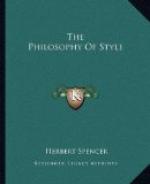28. This question may sometimes be decided by considering the capacity of the persons addressed. A greater grasp of mind is required for the ready comprehension of thoughts expressed in the direct manner, where the sentences are anywise intricate. To recollect a number of preliminaries stated in elucidation of a coming idea, and to apply them all to the formation of it when suggested, demands a good memory and considerable power of concentration. To one possessing these, the direct method will mostly seem the best; while to one deficient in them it will seem the worst. Just as it may cost a strong man less effort to carry a hundred-weight from place to place at once, than by a stone at a time; so, to an active mind it may be easier to bear along all the qualifications of an idea and at once rightly form it when named, than to first imperfectly conceive such idea and then carry back to it, one by one, the details and limitations afterwards mentioned. While conversely, as for a boy, the only possible mode of transferring a hundred-weight, is that of taking it in portions; so, for a weak mind, the only possible mode of forming a compound conception may be that of building it up by carrying separately its several parts.
29. That the indirect method—the method of conveying the meaning by a series of approximations—is best fitted for the uncultivated, may indeed be inferred from their habitual use of it. The form of expression adopted by the savage, as in “Water, give me,” is the simplest type of the approximate arrangement. In pleonasms, which are comparatively prevalent among the uneducated, the same essential structure is seen; as, for instance, in—“The men, they were there.” Again, the old possessive case —“The king, his crown,” conforms to the like order of thought. Moreover, the fact that the indirect mode is called the natural one, implies that it is the one spontaneously employed by the common people: that is—the one easiest for undisciplined minds.
30. There are many cases, however, in which neither the direct nor the indirect structure is the best; but where an intermediate structure is preferable to both. When the number of circumstances and qualifications to be included in the sentence is great, the most judicious course is neither to enumerate them all before introducing the idea to which they belong, nor to put this idea first and let it be remodeled to agree with the particulars afterwards mentioned; but to do a little of each. Take a case. It is desirable to avoid so extremely indirect an arrangement as the following:—“We came to our journey’s end, at last, with no small difficulty after much fatigue, through deep roads, and bad weather.” Yet to transform this into an entirely direct sentence would not produce a satisfactory effect; as witness:—“At last, with no small difficulty, after much fatigue, through deep roads, and bad weather, we came to our journey’s end.”




